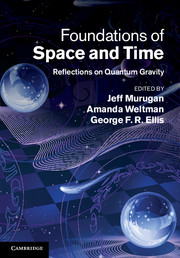Book contents
- Frontmatter
- Contents
- List of contributors
- 1 The problem with quantum gravity
- 2 A dialogue on the nature of gravity
- 3 Effective theories and modifications of gravity
- 4 The small-scale structure of spacetime
- 5 Ultraviolet divergences in supersymmetric theories
- 6 Cosmological quantum billiards
- 7 Progress in RNS string theory and pure spinors
- 8 Recent trends in superstring phenomenology
- 9 Emergent spacetime
- 10 Loop quantum gravity
- 11 Loop quantum gravity and cosmology
- 12 The microscopic dynamics of quantum space as a group field theory
- 13 Causal dynamical triangulations and the quest for quantum gravity
- 14 Proper time is stochastic time in 2D quantum gravity
- 15 Logic is to the quantum as geometry is to gravity
- 16 Causal sets: discreteness without symmetry breaking
- 17 The Big Bang, quantum gravity and black-hole information loss
- 18 Conversations in string theory
- Index
- References
6 - Cosmological quantum billiards
Published online by Cambridge University Press: 05 August 2012
- Frontmatter
- Contents
- List of contributors
- 1 The problem with quantum gravity
- 2 A dialogue on the nature of gravity
- 3 Effective theories and modifications of gravity
- 4 The small-scale structure of spacetime
- 5 Ultraviolet divergences in supersymmetric theories
- 6 Cosmological quantum billiards
- 7 Progress in RNS string theory and pure spinors
- 8 Recent trends in superstring phenomenology
- 9 Emergent spacetime
- 10 Loop quantum gravity
- 11 Loop quantum gravity and cosmology
- 12 The microscopic dynamics of quantum space as a group field theory
- 13 Causal dynamical triangulations and the quest for quantum gravity
- 14 Proper time is stochastic time in 2D quantum gravity
- 15 Logic is to the quantum as geometry is to gravity
- 16 Causal sets: discreteness without symmetry breaking
- 17 The Big Bang, quantum gravity and black-hole information loss
- 18 Conversations in string theory
- Index
- References
Summary
The minisuperspace quantization of D =11 supergravity is equivalent to the quantization of an E10/K(E10) coset space sigma model, when the latter is restricted to the E10 Cartan subalgebra. As a consequence, the wavefunctions solving the relevant minisuperspace Wheeler-DeWitt equation involve automorphic (Maass wave) forms under the modular group W+(E10)≅ PSL2(0). Using Dirichlet boundary conditions on the billiard domain a general inequality for the Laplace eigenvalues of these automorphic forms is derived, entailing a wave function of the universe that is generically complex and always tends to zero when approaching the initial singularity. The significance of these properties for the nature of singularities in quantum cosmology in comparison with other approaches is discussed. The present approach also offers interesting new perspectives on some longstanding issues in canonical quantum gravity.
Introduction
The present chapter is based on [1], and elaborates on several issues and arguments that were not fully spelled out there. In that work, a first step was taken towards quantization of the one-dimensional “geodesic” E10/K(E10) coset model which had been proposed in [2] as a model of M-theory. Here, E10 denotes the hyperbolic Kac-Moody group E10 which is an infinite-dimensional extension of the exceptional Lie group E8, and plays a similarly distinguished role among the infinite-dimensional Lie algebras as E8 does among the finite-dimensional ones. The proposal of [2] had its roots both in the appearance of so-called “hidden symmetries” of exceptional type in the dimensional reduction of maximal supergravity to lower dimensions [3], as well as in the celebrated analysis of Belinskii, Khalatnikov and Lifshitz (BKL) [4] of the gravitational field equations in the vicinity of a generic space-like (cosmological) singularity.
- Type
- Chapter
- Information
- Foundations of Space and TimeReflections on Quantum Gravity, pp. 106 - 124Publisher: Cambridge University PressPrint publication year: 2012
References
- 1
- Cited by



